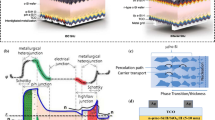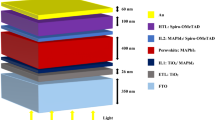Abstract
Nanocrystalline Si:H is an important material for solar cells. The electronic properties of the material depend critically upon the degree of crystallinity, the efficacy of passivation of the grain boundaries and concentration of impurities, particularly oxygen, in the material. In this paper, we examine different degrees of passivation of grain boundaries by amorphous Si, by deliberately introducing various thicknesses of amorphous tissue layers at the grain boundaries. The device structure consisted of a p+nn+ cell on stainless steel.The base n layer was fabricated using alternating layers of amorphous (a-Si) and crystalline (nc-Si) phases, creating a superlattice structure. The thicknesses of the amorphous and crystalline phases were varied to study their influence on structural and electrical properties such as grain size and diffusion length. We find that <111> grains continued to be nucleate independently of the thickness of the amorphous layer, but the size of <220> grains decreased when the thickness of the tissue layer became very large. We also find that as the thickness of the amorphous tissue layer increased, the quantum efficiency at 800 nm decreased and the open circuit voltage increased. For significant thickness of amorphous layer (>10nm), the transport properties degrade dramatically, causing an inflection in the I-V curve, probably because of difficulty of holes tunneling across the barriers.
Similar content being viewed by others
References
Kenji Yamamoto, Masashi Yoshimi, Yuko Tawada, Susumu Fukuda, Toru Sawada, Tomomi Meguro, Hiroki Takata, Takashi Suezaki, Yohei Koi, Katsuhiko Hayashi Solar Energy Mater. and Solar Cells, 74, 449 (2002)
A. V. Shah, J. Meier, E. Vallat-Sauvain, N. Wyrsch, U. Kroll, C. Droz and U. Graf, Solar Energy Mater. and Solar Cells, 78, 469 (2003)
B. Rech, O. Kluth, T. Repmann, T. Roschek, J. Springer, J. Müller, F. Finger, H. Stiebig and H. Wagner, Solar Energy Mater. and Solar Cells, 74, 439 (2002)
K. Yamamoto, A. Nakajima, M. Yoshimi, T. Sawada, S. Fukuda, K. Hayashi, M. Ichikawa, Y. Tawada, Proc. 29th. IEEE Photovolt. Spec. Conf.(2002), p.1110
A. Sazonov, D. Striakhilev, C-H Lee, and A. Nathan: Proceedings of the IEEE, 93, 1420 (2005).
I-C Chen and S. Wagner: IEE Proc.- Circuits, Devices Syst., 150, 339(2003).
B. C. Pan and R. Biswas,J. Appl. Phys. 96,6247(2004)
Vikram L. Dalal, Kamal Muthukrishnan, Satya Saripalli, Dan Stieler and Max Noack, Proc. MRS, 910, 293(2006)
S. R. P. Silva, R. D. Forrest, J. M. Shannon, and B. J. Sealy , J. Vac.Sci. and Tech. B, 17,596(1999)
Author information
Authors and Affiliations
Rights and permissions
About this article
Cite this article
Madhavan, A., Ghosh, D., Noack, M. et al. Influence of Amorphous Layers on Performance of Nanocrystalline/Amorphous Superlattice Si Solar Cells. MRS Online Proceedings Library 989, 1802 (2006). https://doi.org/10.1557/PROC-0989-A18-02
Received:
Accepted:
Published:
DOI: https://doi.org/10.1557/PROC-0989-A18-02




